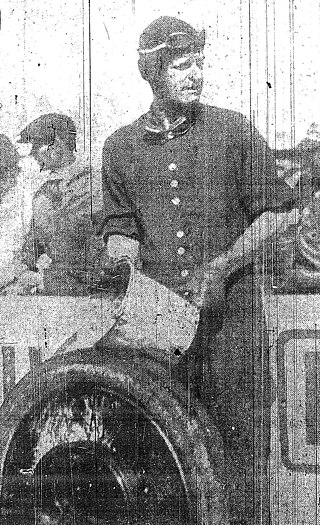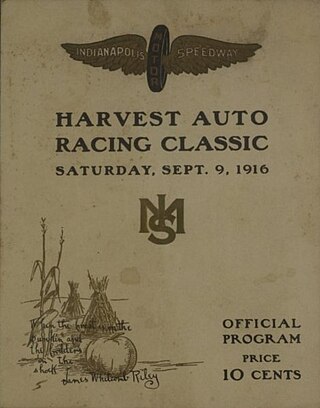
Dario Raoul Resta, was a British racing driver. He is best remembered for his successes racing Indy cars in the United States. The 1916 American National Champion, Resta was the winner of the 1916 Indianapolis 500, as well as the Vanderbilt Cup in 1915 and 1916.

The 1911 International 500-Mile Sweepstakes Race was held at the Indianapolis Motor Speedway on Tuesday, May 30, 1911. It was the inaugural running of the Indianapolis 500, which is one of the most prestigious automobile races in the world. Ray Harroun, an engineer with the Marmon Motor Car Company, came out of retirement to drive, and won the inaugural event before re-retiring for good in the winner's circle.

The 1912 Indianapolis 500-Mile Race, or International 500-Mile Sweepstakes Race, the second such race in history, was held at the Indianapolis Motor Speedway on Thursday, May 30, 1912. Indiana-born driver Joe Dawson won the race, leading only the final two laps. Ralph DePalma dominated the race, leading 196 of the 200 laps, and pulling out to an over 5-lap lead. But with just over two laps to go, his car failed with a broken connecting rod.

The 6th International 300-Mile Sweepstakes Race was the sixth running of the Indianapolis 500. It was held at the Indianapolis Motor Speedway on Tuesday, May 30, 1916. The management scheduled the race for 120 laps, 300 miles (480 km), the only Indianapolis 500 scheduled for less than 500 miles (800 km).

The 7th Liberty 500-Mile Sweepstakes was held at the Indianapolis Motor Speedway on Saturday, May 31, 1919.
The 25th International 500-Mile Sweepstakes was held at the Indianapolis Motor Speedway on Monday, May 31, 1937. With temperatures topping out at 92 °F (33 °C), it is one of the hottest days on record for the Indy 500.

The 9th International 500-Mile Sweepstakes Race was held at the Indianapolis Motor Speedway on Monday, May 30, 1921.

The 4th International 500-Mile Sweepstakes Race was held at the Indianapolis Motor Speedway on Saturday, May 30, 1914.

John Donald Aitken was an American racing driver from Indianapolis, who was active in the years prior to World War I. Aitken competed in the Indianapolis 500 three times. He started the race twice, in 1911 and 1916. He led the first lap of the first race (1911). Aitken captured the pole position in 1916, but ended up in 15th place that year. In the 1915 Indianapolis 500, Aitken drove relief for two drivers, Gil Anderson and Earl Cooper.

Charles Cleveland Merz was an American racing driver, military officer, engineering entrepreneur, and racing official. Active in the early years of the Indianapolis 500, he later became Chief Steward of the Memorial Day Classic.
The 1910 Grand Prix season was the fifth Grand Prix racing season. Because of the ongoing international economic recession, there were no Grandes Épreuves held. The American Grand Prize was held in Savannah.
The 1911 Grand Prix season consisted of Grand Prix races in the United States and Europe. It was a significant year as European racing gradually came out of the doldrums. A Grand Prix was held in France again. The first Indianapolis 500 was held at Indianapolis Motor Speedway, joining the American Grand Prize as a leading race.
The 1912 Grand Prix season saw Grand Prix motor racing in Europe and the United States. The growing economic confidence and interest from car manufacturers saw bigger fields and more races in the season. The French Grand Prix was held for the first time since 1908 and staged at Dieppe. The American Grand Prize was held in Milwaukee, moving from its previous home in Savannah.
The 1913 Grand Prix season consisted of Grand Prix races in Europe and the United States. Once again, the Peugeot works cars were the team to beat, continuing their success. This year the French Grand Prix was held in Amiens. The ACF introduced a fuel-economy formula for the race to discourage bigger-engined cars. Peugeot drivers Georges Boillot and Jules Goux claimed a 1-2 victory for the company after Zuccarelli had been killed in practice.

The 1914 Grand Prix season consisted of Grand Prix races across Europe and the United States until abbreviated by the outbreak of World War I.
The 1916 Grand Prix season saw Grand Prix motor racing continue in the United States. Racing was suspended in Europe due to the World War I engulfing the continent. Once again European cars dominated Indianapolis with victory going to Briton Dario Resta in a Peugeot. With the organisers wanting to appeal to the spectators, this was the only year that the race was scheduled for a shorter length – to run only 300 miles. The Vanderbilt Cup and the American Grand Prize returned to Santa Monica, California, at the end of the year. Resta repeated his victory from the year before, winning the Vanderbilt Cup. Then when he retired in the Grand Prize it was Howdy Wilcox and Johnny Aitken who won in another of the dominant Peugeots. Oval courses now dominated the AAA Championship with these two events being the only road-course races this year. It proved to be the final time these two formative American races were held in this format; while racing in America continued throughout the First World War, public interest had shifted away from road racing.

The Harvest Auto Racing Classic was a series of three automobile races held at the Indianapolis Motor Speedway on Saturday September 9, 1916. The meet, held four months after the 1916 Indianapolis 500, featured a 20-mile race, a 50-mile race, and a 100-mile race. The main event, a 100-mile Championship Car race, paid points towards the 1916 AAA National Championship. Johnny Aitken won all three races, two of which had a margin of victory of less than a car length.
The 1919 Grand Prix season was the first season following the armistice that ended World War I in November 1918. European economies were struggling, and many automotive firms had to recover and retool from military production. So, there was very little racing activity as it took time for the companies and populations to recover. As the world rebuilt there were only two major races held in the year – the Indianapolis 500 and the Targa Florio.

Ernest Henry was a mechanical engineer. He developed auto racing engines, and is especially well known for his work for Peugeot and Ballot, who dominated Grand Prix auto racing from 1912 to 1921. His engine design directly influenced Sunbeam Racing cars as early as 1914; the 1921 Grand Prix Sunbeams owe much to his work with Ballot and the 1922 Grand Prix Sunbeams were designed by him.














